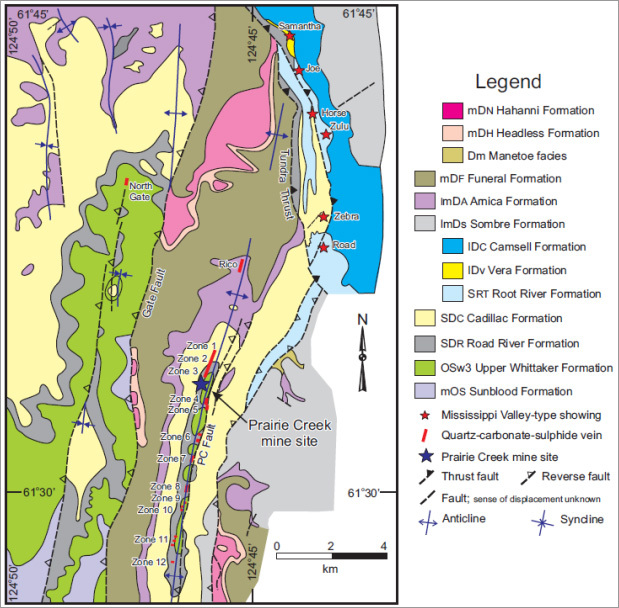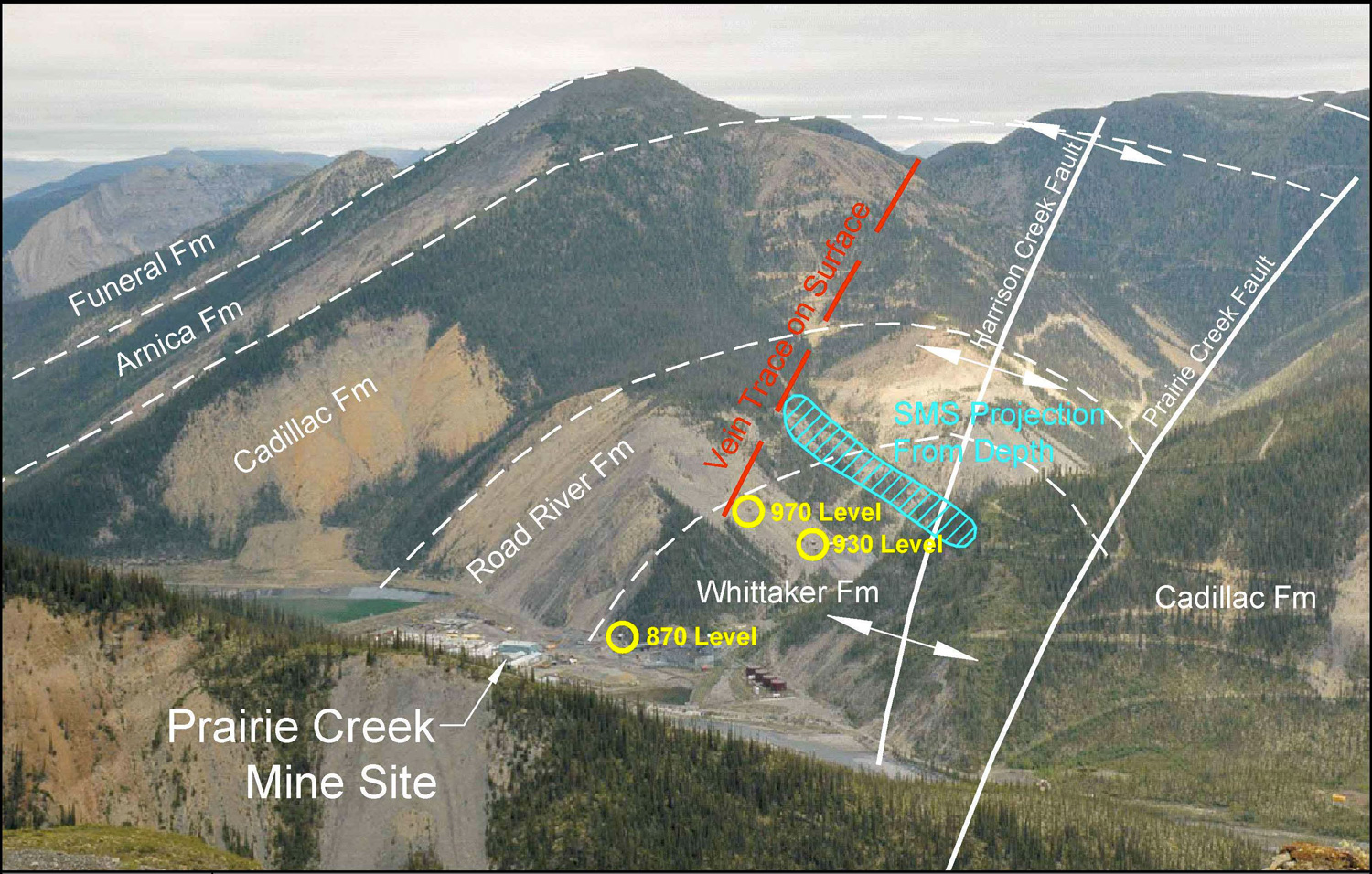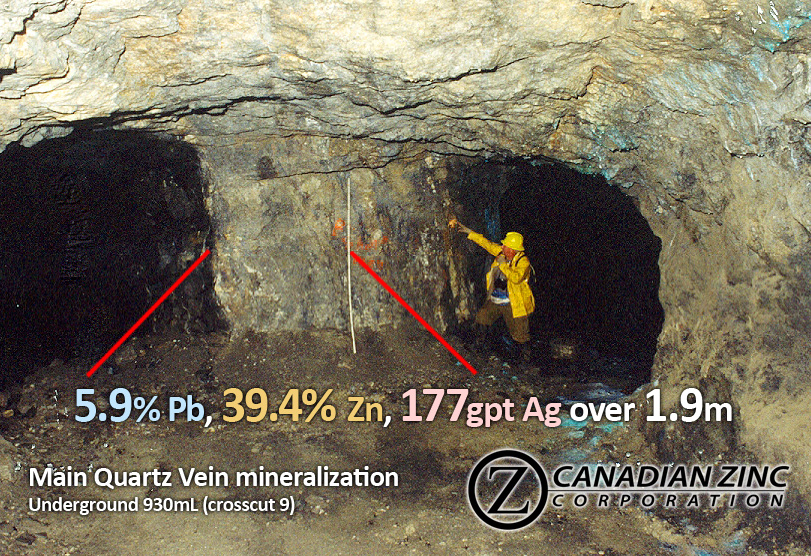Regional Geology
The property geology is dominated by Siluro-Devonian stratigraphy that formed in a paleo-basin adjacent to ancient North American platformal sediments. East-dipping and west-dipping thrusts define the present margins of the Prairie Creek paleo-basin in which sediments accumulated.
Structural deformation during the Laramide orogeny caused folding and faulting of the Prairie Creek paleo-basin, which broke into a series of north-south trending, five to 20 kilometre fault blocks. NorZinc’s mineral leases overlie two major fault blocks of sediments: the Prairie Creek Block and the western Gate Block.
The Prairie Creek block is outlined by a 1-2 kilometre wide doubly plunging antiform with a north-south trending fold axis. It is underlain by a conformable sedimentary sequence ranging from Lower Ordovician to Silurian in age. The antiform plunges at about 15 degrees to the north, so the geological units young in age to the north.

Regional Geology
Site Geology
The Mine Site is situated on the western flank of the Prairie Creek antiform referred to as the Main Zone, which hosts the entirety of the defined mineral resource. The Ordovician-age Upper Whittaker Formation is the oldest geological formation in this area and is composed of interbedded cherts and dolomites that form the core of the Prairie Creek antiform. The Upper Whittaker Formation is overlain by a large exposure of the carbon-rich graphitic-shales/dolomites of the Road River Formation. The iron-bearing Cadillac Formation shales overly the Road River Formation and are located immediately adjacent to the mine site. The bluff-forming rocks immediately to the west of the mine site are formed by the cherty Arnica Formation which overlies the Cadillac Formation and forms the more resistant hilltops in the immediate vicinity of the Mine Site.
The Gate Block is located to the west of the Prairie Creek Block and overlies similar but flat-lying rock assemblages. Grassroots exploration was completed on the Gate Block and identified geochemical soil anomalies and mineralized float that warrant further exploration.
Three main styles of base metal mineralization have been identified in the Main Zone: main quartz vein (“MQV”), stratabound massive sulphides (“SMS”), and stockwork (“STK”) mineralization. Base metal mineral showings occur along the entire 16 kilometre north to south length of the Prairie Creek property.

Stratigraphy and structure looking north towards the Main Zone
Main Quartz Vein
The Main Quartz Vein (“MQV”) is a polymetallic fault-hosted zinc-lead-silver quartz vein, which dips near vertical and is usually between 3 and 5 metres wide. The MQV occurs parallel to the axial plane of the antiform. Mineralization consists of massive to disseminated galena and sphalerite with lesser pyrite and tennantite-tetrahedrite in a quartz-carbonate-dolomite matrix. Secondary oxidation is locally developed, yielding cerussite (lead oxide) and smithsonite (zinc oxide). Silver is present in solid solution with tennantite-tetrahedrite and to a lesser extent with galena.
Underground development has proved 940 metres of MQV strike length, and diamond drilling has extended its inferred continuance for a further 1.2 kilometres. Exploratory drilling conducted from a valley 1.8 kilometres north of the inferred resource suggests that the vein may continue much further. Evidence from surface showings and diamond drilling suggest it continues for a further four kilometres south of the Main Zone.

Main Quartz Vein mineralization in the underground 930 mL, X-Cut 09
Stratabound Massive Sulphide Mineralization
Stratabound Massive Sulphide (“SMS”) mineralization occurs in the lower portion of the Main Zone and is crosscut by the Main Quartz Vein.
SMS mineralization consists of banded to semi-massive fine-grained sphalerite, coarse-grained galena and disseminated to massive pyrite. SMS contains only half as much galena, but substantially more iron sulphide/pyrite than typical Main Quartz Vein material. Silver is contained in solid solution within galena.
Stockwork Type Mineralization
Stockwork (“STK”) mineralization occurs as a series of narrow sphalerite-tennantite veins developed at about 40 degrees difference in strike to the average trend of the MQV. This mineralization developed in sub-vertical tensional openings created by early north-south stresses, followed by primary movement along the main vein structure. The sulphide mineral assemblages are similar to those outlined for MQV material. The STK mineralization is exposed along 80m of its strike length in the 930mL underground workings, and underground drilling has provided enough information that this mineralization style is now included in the mine plan.
Unless otherwise indicated, all scientific and technical information relating to NorZinc’s mineral projects contained on this page has been reviewed and approved by Kerry Cupit, P. Geo., who by reason of education, membership in professional associations (as defined in National Instrument 43-101 Standards of Disclosure for Mineral Projects (“NI 43-101“) and past relevant work experience, fulfills the requirements of a Qualified Person as defined in NI 43- 101. Mr. Cupit is an Exploration and Project Manager employed by NorZinc, with a B.Sc. in Earth Sciences (Geology). The information on this page is derived from results from a Preliminary Economic Assessment (“PEA”) set out in the Company’s press release dated October 21, 2021. The PEA was prepared in accordance with National Instrument 43-101 Standards of Disclosure for Mineral Projects (“NI 43-101”) and led by Ausenco, with contributions from Global Mineral Resource Services, Mining Plus and F. Wright Consulting. The Technical Report for the Preliminary Economic Assessment for the Prairie Creek Project will be filed on SEDAR (www.sedar.com) within 45 days of this press release.
